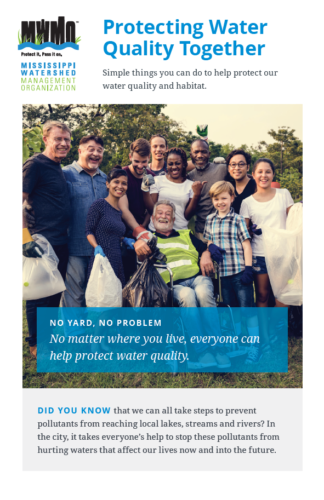
Wondering what you can do to protect water? These simple, everyday actions will help stop pollutants from entering stormpipes under our streets and flowing directly into waterbodies.
Adopt a Storm drain
Storm drains are a direct pipeline to nearby rivers and lakes. Keeping your local storm drain clear of leaves, trash and other debris will ensure that these materials don’t end up in waterbodies. It will also help prevent localized flooding that can occur if storm drains become clogged.
Be sure to clean both the storm drain and the area around it. Dispose of trash, leaves and grass you find there in the proper way. In the winter, sweep up leftover road salt or sand near storm drains. (You can either save it and reuse it or dispose of it.)
Pick Up Your Pet’s Waste
We love our pets, but their waste contains E. coli bacteria and phosphorous — two pollutants that are harmful to water quality. E. coli is also a threat to human health. When it rains, stormwater washes these pollutants off the landscape and into the stormsewers.
Properly disposing of your pet’s waste ensures that these pollutants stay out of our rivers, lakes and wetlands.
Use Commercial Car Washes
If you wash your car in your driveway, you’re sending the dirty, soapy runoff into a nearby storm drain. Instead, you should take your vehicle to a commercial car wash. These businesses are required to capture and properly dispose of the dirt- and chemical-laced rinse water.
As an alternative, you could wash your car in an area where the water will soak into the ground — such as a patch of gravel or a grassy area. (Just be aware that cleaning chemicals may hurt the grass!)
Eliminate Waste
Reduce water pollution by only buying things you need. This reduces negative impacts on water that sometimes occur during manufacturing of various products. It also helps keep down the amount of trash that ends up in the environment.
Buy items made from recycled materials, and join your city in recycling or composting programs.
Support Projects and Policies that Keep Water Clean
Build your understanding of water quality issues. Ask for information from organizations that are managing projects or writing policies that may affect waterbodies. Participate in public meetings, and contact your elected representatives to constructively share your views.
Also, don’t forget to enjoy time with others that share your interests. Look for volunteer opportunities like community clean-ups, habitat restoration or pollinator protection.